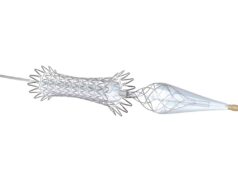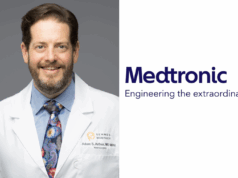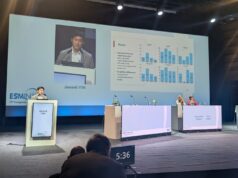This advertorial is sponsored by Medtronic.
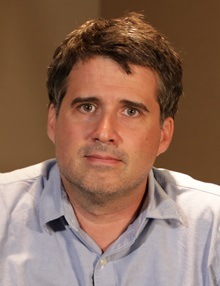
As part of the company’s ongoing commitment to offering physicians access to high-quality clinical data and, subsequently, enabling evidence-based practice to flourish, Medtronic has established a global registry—dubbed ‘INSPIRE-S’—producing real-world findings relating to the treatment of acute ischaemic stroke patients. Sitting down with NeuroNews, Marc Ribó (Vall d’Hebron University Hospital, Barcelona, Spain), who is part of the INSPIRE-S steering committee, outlines what he feels are the key benefits held by a large registry of this kind.
“The strength of the INSPIRE-S registry is that it captures safety and efficacy [data] in real-life practice, and across all types of hospitals—bigger and smaller hospitals, and high- and low-volume centres, in different countries around Europe, South America and Asia,” he says, averring that, as such, the investigators may also be able to identify discrepancies between different regions and centres.
Having predominantly enrolled stroke patients across more than 30 hospitals in Europe to date, including in Belgium, Finland, France, Germany, Greece, Poland, Portugal, Spain, Switzerland and the UK, INSPIRE-S has more recently expanded into Argentina, as well as Hong Kong and Israel, with an additional cohort currently being enrolled in China too.
In INSPIRE-S, data are being collected on two key product families from Medtronic’s neurovascular portfolio: the company’s SolitaireTM revascularisation devices, and its ReactTM catheters, both of which are widely used in the treatment of acute ischaemic stroke patients. According to Ribó, these technologies are being evaluated as “standalone” mechanical thrombectomy solutions, but also in combination, whereby a stent retriever and an aspiration catheter are deployed simultaneously to maximise the likelihood of procedural success being achieved in the lowest possible number of attempts.
Clinical and technical outcomes
Earlier this year, at the LINNC Paris Course (5–7 June 2023, Paris, France), Ribó delivered the most recent major update from INSPIRE-S, initially reporting that more than 800 acute ischaemic stroke patients have been enrolled in this prospective, global registry to date. The presenter relayed findings from an interim analysis solely focused on one of the registry’s three patient cohorts—the combination therapy group, in which eligible patients were treated with Solitaire alongside React, or another market-approved aspiration catheter device.
Ribó highlighted the fact that Solitaire was used specifically in combination with React in the vast majority of cases (68/71); a balloon guide catheter (BGC) was used at the first pass in 32.9% of cases; and most of the patients in the combination therapy cohort (80.8%) presented with M1/M2 middle cerebral artery (MCA) occlusions.
Across 258 enrolled patients, the registry’s primary effectiveness measure of a good functional outcome (modified Rankin scale [mRS] 0–2 or return to pre-stroke mRS) at 90 days post-intervention was achieved in 51.8% of the patients who received combination therapy and for whom site-reported data were available at three months. Ribó also highlighted the fact that, following the exclusion of 32 patients whose pre-stroke mRS score was either ≥3 or “unavailable”, the rate of good functional outcomes rose to 55.4%.
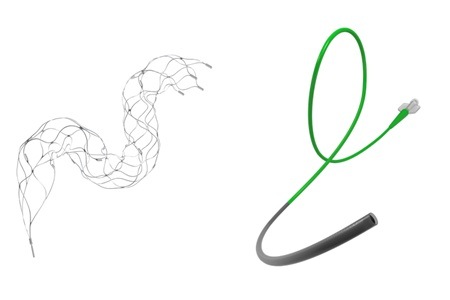
© 2024, November Medtronic, Inc. REPRINTED WITH PERMISSION-ALL RIGHTS RESERVED
As per several other prespecified endpoints of this analysis, the presenter further highlighted a 91.6% overall rate of successful revascularisation (expanded thrombolysis in cerebral infarction [eTICI] ≥2b50); a first-pass effect (eTICI≥2c) rate of 47.5%; and symptomatic intracranial haemorrhage (sICH) and clinical events classification (CEC) -adjudicated neurological death rates of 0.8%, and 6.6%, respectively.
In discussion with NeuroNews, Ribó notes that the registry’s combination therapy cohort was the first part of INSPIRE-S to meet its enrolment target, with final data from the stent retriever- and aspiration[1]only groups set to feature in future presentations and publications. He goes on to state that both of these remaining registry arms are “filling up”, and that the hope is for these analyses to be completed and available in 2024.
Complementing randomised trials
“The INSPIRE-S registry is a way [for us] to collect data on the safety and efficacy of Medtronic’s products for acute ischaemic stroke from real-world, standard, daily clinical practice,” Ribó says. “Generally, we have [published] data available about the performance of devices in clinical studies—and this has high value, but is also performed under certain conditions that are not [reflective of] daily practice.”
According to Ribó, while controlled trials often contribute to the initial regulatory approval of a device, their restrictive nature means that their data and the outcomes they produce may not be the same as those seen in a real-world clinical setting.
“This is why these registries are complementary to the information that we get from clinical studies,” he continues, “and they are able to be expanded to a wide number of centres—some of which may not be as used to participating in clinical trials—and we can also see the effect in a [patient] population that is not strictly the same as the one fulfilling the inclusion/ exclusion criteria of a clinical trial.
The strength of the INSPIRE-S registry is that it captures safety and efficacy [data] in real-life practice, and across all types of hospitals.
“Anybody who receives treatment with these devices is registered, or at least should be registered, in INSPIRE-S, and in the end we collect a different kind of information that is hopefully similar to—or sometimes even better than—the results obtained in clinical studies.”
Here, Ribó alludes to what is likely to be considered as the main potential limitation to these types of registries: the fact that individual participating centres and investigators can be selective over which patients they ultimately include in the data they submit for core-lab adjudication.
“It is important that they report all the patients treated, and do not just cherry pick those in which the outcome was good,” he adds. “This is a potential bias, which is difficult to avoid—investigators might, in some cases, be reluctant to report cases in which the outcomes were not so good. And that does not happen in clinical trials, because you include the patient before they are treated and, independent of the outcome, they are going to be in the trial.”
Ribó notes that what can be done, and what is being done by those leading INSPIRE-S, is to speak to the participating centres and impress upon them the importance of reporting their data “fairly”, rather than being tempted to exclude any cases with poorer outcomes, “for the sake of the registry”. He goes on to claim that, “otherwise, the information is useless—if you only report the ‘good’ patients, the registry is not worth doing”.
Future directions
“Of course, for Medtronic, these are great results— they have shown a recanalisation rate over 90% with basically no safety concerns,” Ribó adds, drawing the conversation to a close.
“But, the results will also be able to give us tips regarding some secondary questions. Is it better to do a manual aspiration or use a pump? It seems [based on INSPIRE-S] that it does not matter. Is it better to use React 71 or 68, according to the location of the occlusion? For proximal occlusions, it seems that it is always better to maximise the diameter of the catheter. Is [combination therapy] effective regardless of the aetiology of the stroke; cardioembolic or atherosclerotic? This does appear to be the case.”
Based on these indications, Ribó notes that it is “reassuring” to see that the efficacy of revascularisation with a combined approach remains consistent across different stroke aetiologies, times from symptom onset, and clot locations. He also states that—owing to the granularity of the data collected within INSPIRE-S—these questions and many others, from the impact of stent-retriever size on recanalisation, to the efficacy of introducing a BGC alongside this combined approach, can now be investigated further.
“So, that is another strength of this registry: it is a very comprehensive registry that captures many details of the procedure and, from there, you can do many, many detailed analyses,” Ribó summarises. “We cannot do a clinical trial for each of these little niches, so the only way—and it is a very good way—is a registry.”
DISCLAIMERS:
Solitaire™ is a trademark of Medtronic, Inc.
React™ is a trademark of Medtronic, Inc.

